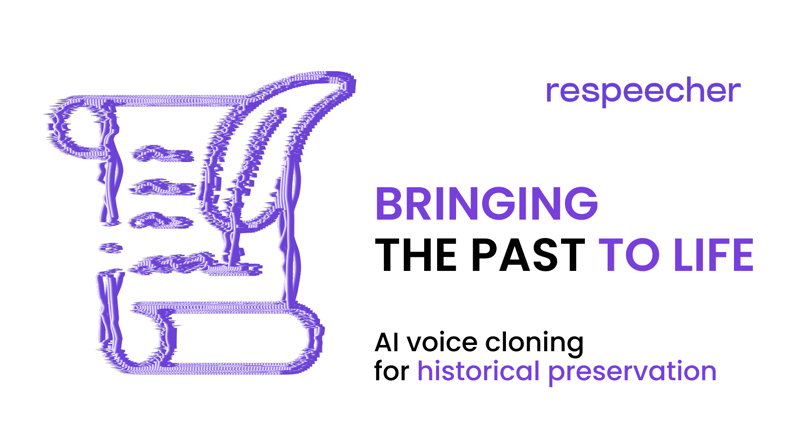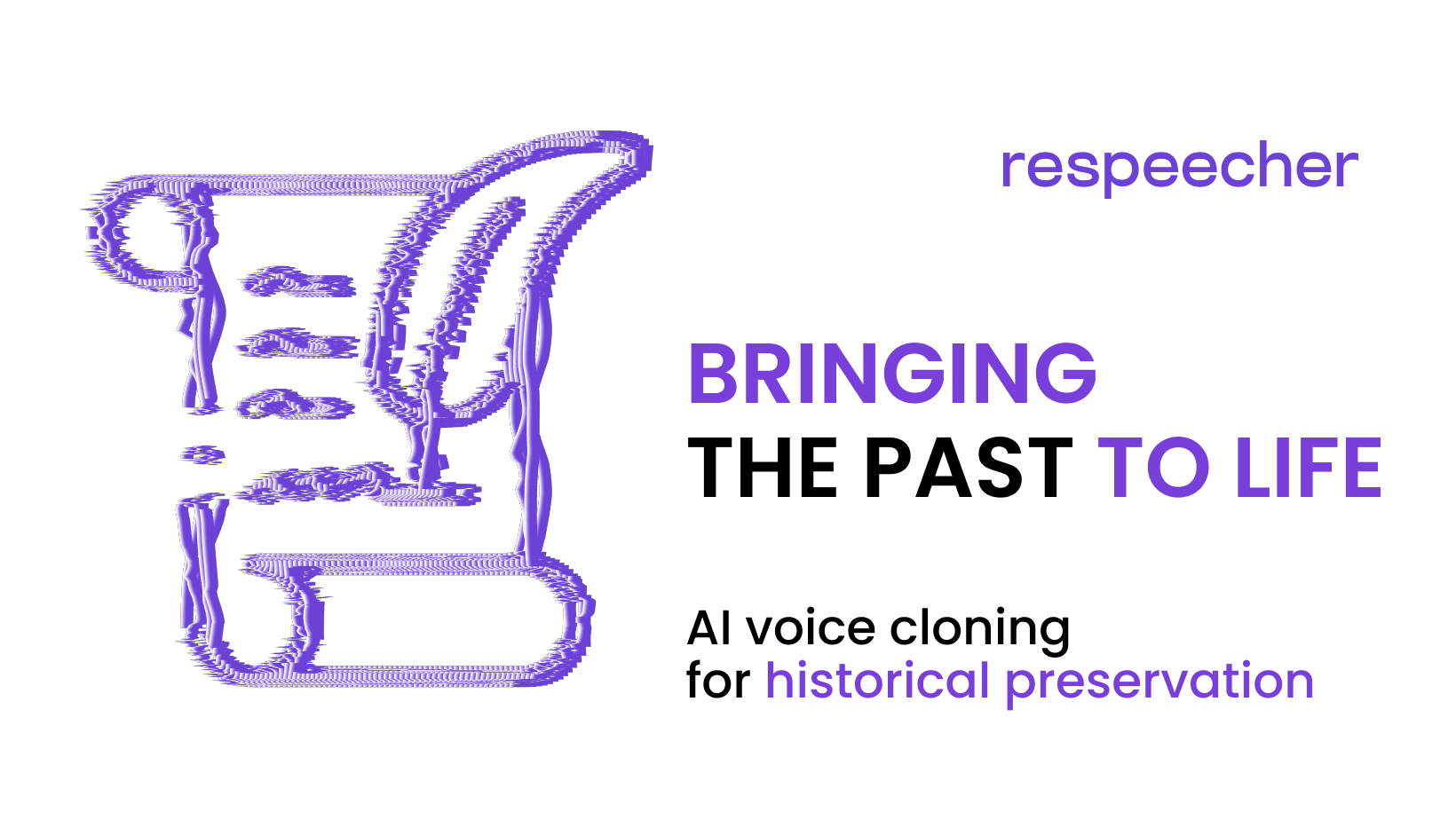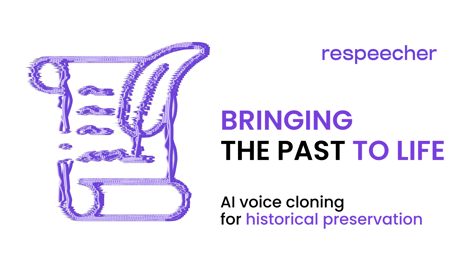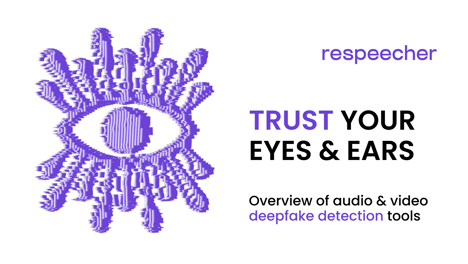AI Voice Cloning for Historical Preservation: Bringing the Past to Life

AI voice cloning, a cutting-edge technology that uses artificial intelligence to replicate human voices, is transforming various industries, including historical preservation. By analyzing voice samples and generating synthetic speech that mimics the original speaker's tone, pitch, and nuances, voice AI in history education brings a new dimension to how we experience and interact with it. This technology holds the potential to breathe life into the past, providing an auditory experience that allows us to hear the voices of historical figures, narrate historical events, and preserve the vocal characteristics of individuals from bygone eras. In other words, it's the way to give history a new voice.
The Technology Behind Voice Cloning
Voice cloning technology functions through sophisticated artificial intelligence algorithms that analyze and replicate human speech patterns. The process involves two main stages: training and synthesis. During the training phase, a model is fed numerous voice samples from the target speaker. These samples are used to teach the AI to understand and replicate the unique vocal characteristics, including tone, pitch, accent, and rhythm. In the synthesis phase, the AI uses this learned information to generate synthetic speech that closely mimics the original voice. Real-time voice cloning (also called speech-to-speech voice synthesis) takes this further, enabling the AI to produce synthetic speech almost instantaneously, allowing for dynamic interactions using the cloned voice AI.
Recent advancements in AI have significantly enhanced the accuracy and realism of voice synthesis. Breakthroughs in machine learning, particularly deep learning techniques, have allowed for the development of more sophisticated neural networks capable of capturing the subtle nuances of human speech.
Applications in Museums
Museums worldwide increasingly adopt AI voice cloning technology to create interactive exhibits that captivate and educate visitors. For instance, the Smithsonian Institution has used voice cloning to recreate the voices of significant historical figures (or their holograms), allowing visitors to hear famous speeches and personal anecdotes as if they were being spoken live. Similarly, Anne Frank's House in Amsterdam utilizes voice cloning to narrate passages from Anne Frank's diary in her voice, providing an intimate and poignant experience.
By integrating educational voice cloning into exhibits, museums can offer visitors a more immersive and interactive experience, including holography in museums. This technology allows visitors to engage directly with historical figures, asking questions and receiving real-time responses, creating a more personalized and impactful visit. Hearing the authentic voices of people from the past can evoke strong emotional connections and a deeper understanding of historical events. Moreover, interactive audio guides powered by voice cloning in museums can provide context-sensitive information, adapting to the interests and preferences of each visitor.
Voice Cloning in Educational Settings
Schools and educational programs are leveraging voice cloning technology to enhance the study of history by recreating historical speeches and debates. For example, students can listen to Abraham Lincoln deliver the Gettysburg Address in his voice or hear Winston Churchill's stirring speeches during World War II. This immersive approach allows students to experience history firsthand, fostering a deeper connection. Teachers can incorporate these authentic audio experiences into their lessons, making historical events more vivid and engaging. By bringing the voices of the past into the classroom, voice cloning helps bridge the gap between historical texts and the lived experiences they describe.
Voice cloning also plays a pivotal role in multilingual education, making historical content accessible to a wider audience. Educational programs can use this technology to translate and narrate historical texts, speeches, and documentaries in multiple languages while preserving the original vocal characteristics of the speakers thanks to AI dubbing. This ensures that non-native speakers and students in bilingual or multilingual settings can benefit from an equally rich and authentic learning experience. Another challenge that became easier with the introduction of AI voice cloning is reproducing children's voices for educational projects.
Ethical Considerations
The use of AI voice cloning in museums to recreate the voices of historical figures raises several ethical concerns, particularly regarding accuracy and respect for historical context. Ensuring that the recreated voices and the content they deliver are historically accurate is crucial to maintaining the integrity of historical narratives. Misrepresenting a historical figure’s words or tone can lead to a distorted understanding of history. Moreover, there is a moral responsibility to portray these figures respectfully and authentically, acknowledging their contributions and the context in which they lived and spoke. The ethical implications of altering these voices for contemporary purposes must be carefully considered avoiding misrepresentation and misuse, especially during dubbing and localization.
Transparency is essential when using synthetic media, including artificial intelligence (AI) voice cloning. Users and audiences must be informed when interacting with synthetic voices to maintain trust and authenticity. Clear disclosure helps prevent deception and ensures that the audience understands the context of the content they are consuming. Additionally, ethical guidelines are necessary to govern the use of historical voice synthesis, particularly regarding consent. While obtaining direct consent from historical figures is impossible, institutions should establish AI ethics, such as Respeecher’s ethical principles, that respect the legacy and intentions of these individuals. This includes considering the potential impact on the descendants and communities associated with the replicated historical figures.
Case Studies
Successful Implementations of AI voice synthesis for history preservation include the following cases:
- The United States government considered a scenario in which astronaut Neil Armstrong wouldn't be able to walk on the Moon and prepared a special speech that former US President Richard Nixon intended to read in the event of the mission’s failure. Luckily, he never had to read it, but Respeecher used an AI voice generator to explore an imagined reality in which Neil Armstrong and Edwin “Buzz” Aldrin died while on their mission to the Moon.
- Another example is using generative AI to revive the voice of Manuel Rivera Morales, who gained nationwide fame in Puerto Rico during the 1960s-80s when he covered BSN basketball games live. This project was recently recognized by the SME Awards 2022 and has won three awards.
- Respeecher also created a synthetic rendition of the renowned Greek opera singer Maria Callas. The company was responsible for a part in which Maria handled press conference questions. This meant replicating her voice and capturing the nuances and emotive qualities inherent in her speech.
Feedback from educators and visitors regarding the use of voice-cloned historical figures has been overwhelmingly positive. Educators report that students show increased interest and engagement when lessons include authentic voices from the past. Hearing historical speeches and dialogues in the original voices helps students better grasp the emotions and significance of historical events. Visitors to museums with voice cloning exhibits often describe their experiences as more immersive and impactful.

Conclusion
The future of historical education is poised to be significantly enhanced by AI voice cloning. As this technology advances, its applications in classrooms and museums will become more sophisticated, providing even more immersive and interactive learning experiences. Future developments could include real-time conversational interactions with historical figures, personalized educational content creation tailored to individual learning styles, and expansive multilingual support to democratize media and revolutionize museums. As we at Respeecher embrace the possibilities of AI voice cloning, it is crucial to prioritize ethical development to ensure respectful and accurate historical representation. Continued research and innovation in this field must be guided by ethical standards that preserve the integrity and dignity of historical figures. Transparency in the use of synthetic media is essential, along with stringent guidelines for accuracy and respect.
FAQ
Voice cloning is ethical if used responsibly, with transparency and respect for the individuals being represented. Ensuring historical accuracy, obtaining consent where possible, or following ethical guidelines helps maintain the integrity and dignity of those whose voices are being replicated with deepfake technology.
Historic preservation methods include physical conservation of artifacts and buildings, digitization of documents and images, oral history recordings, and now AI technologies like voice cloning to recreate and preserve the voices of historical figures, providing a more immersive understanding of the past with holographic history.
AI can help preserve culture by digitizing and analyzing cultural artifacts, creating virtual reconstructions of historical sites, and using educational voice cloning to bring historical figures and traditions to life. These technologies ensure that cultural heritage is documented, accessible, and engaging for future generations.
Glossary
Immersive technology
Technology that creates or enhances physical reality by immersing users in a digital environment, often through sensory experiences like sight and sound.
VR (Virtual Reality)
AR (Augmented Reality)
XR (Extended Reality)

- voice synthesis
- voice cloning
- synthetic media
- synthetic speech
- holograms
- artificial intelligence (AI)
- deepfake technology
- voice cloning technology,
- democratize media
- AI voice generator
- speech-to-speech voice synthesis
- Voice acting
- generative AI
- AI voice cloning
- content creation
- AI Ethics
- voice changer
- voice generator
- AI voice clone
- real-time voice cloning
- speech to speech
- AI dubbing
- Respeecher for Business
- voice cloning for podcasts
- voice ai
- dubbing and localization
- multilingual podcasting
- podcast voice generator
- voice cloning ai
- voice cloning in museums
- historical voice synthesis
- educational voice cloning
- recreating historical speeches
- voice AI in history education
- holographic history
- revolutionize museums







